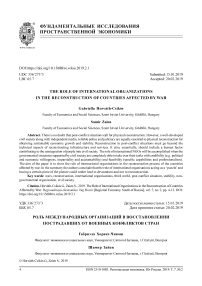The role of international organizations in the reconstruction of countries affected by war
Автор: Horvth-Csiks Gabriella, Zaien Samir
Журнал: Региональная экономика. Юг России @re-volsu
Рубрика: Фундаментальные исследования пространственной экономики
Статья в выпуске: 2 т.7, 2019 года.
Бесплатный доступ
There is no doubt that post-conflict situations call for physical reconstruction. However, a well-developed civil society along with independent media, reliable police and judiciary are equally essential to physical reconstruction for obtaining sustainable economic growth and stability. Reconstruction in post-conflict situations must go beyond the technical aspects of reconstructing infrastructure and services. It also, essentially, should include a human factor contributing to the reintegration of people into civil society. The role of international NGOs will be accomplished when the governmental structures supported by civil society are completely able to take over their tasks with credibility (e.g. political and economic willingness, impartiality and accountability) and feasibility (specific capabilities and professionalism). The aim of the paper is to show the role of international organisations in the reconstruction process of the countries affected by war. In the summary the authors conclude that the role of international organisations acting as a ‘puzzle’ and having a certain piece of the picture could rather lead to devastation and not to reconstruction.
Wars, reconstruction, international organisations, third world, post conflict situation, stability, non- governmental organisation, civil society
Короткий адрес: https://sciup.org/149131329
IDR: 149131329 | DOI: 10.15688/re.volsu.2019.2.1
Список литературы The role of international organizations in the reconstruction of countries affected by war
- Allen T., Alan T., 2000. Poverty and Development into the 21st Century. Oxford; New York, Oxford University Press. 572 p. URL: https://archive.org/details/povertydevelopme00alle/page/n3.
- Diehl P.F., 1994. International Peacekeeping. Baltimor, Johns Hopkins Press. 244 p. URL: https://archive.org/details/internationalpea00dieh.
- Doyle M.M., Sambanis N., 1995. Building Peace: Challenge and Strategies After Civil War. New York, International Peace Academy. 33 p. URL: http://web.msu.ac.zw/elearning/material/1237744983building_peace_challenges_strategies_after_civilwar%5B1%5D.pdf.
- El-Baz Sh., 2005. Globalisation and the Challenge of Democracyin Arab North Africa. Dakar, CODESRIA, vol. XXX, no. 4. 249 p. URL: https://www.jstor.org/stable/i24479532.
- Frances S., 2005. Policies towards Horizontal Inequalities in Post-Conflict Reconstruction. Oxford, Queen Elizabeth House. 42 p. URL: https://statebuildingandfragilitymonitor.files.wordpress.com/2012/01/policies-towards-horizontal-inequalities-in-post-conflict-reconstruction.pdf.
- Corm G., 2003. Financial and Monetary Dilemmas (Workshop on Iraq and the Region After the War). Beirut, ESCWA. 54 p. URL: https://digitallibrary.un.org/record/509264/files/E_ESCWA_SDPD_2003_9-EN.pdf.
- Kreilkamp Ja.S., 2003. U.N. Postconflict Reconstruction. New York University Journal of International Law and Politics. New York. URL: http://nyujilp.org/print-edition/volumes-40-31/.
- Lipsy R.G., Lancaster K., 2000. The General Theory of Second Best. The Review of Economic Studies. Oxford, Oxford University Press, vol. 24, no. 1. 32 p. URL: http://lib.cufe.edu.cn/upload_files/other/4_20140523031928_38_The%20General%20Theory%20of%20the%20Second%20Best.pdf.
- Sen A., 1999. Development as Freedom. Oxford, Oxford University Press. 5 p. URL: http://www.c3l.uni-oldenburg.de/cde/OMDE625/Sen/Sen-intro.pdf.
- Snaderson J., 2005. Ride the Whirlpool: Selected Speeches. Crawley, University of Western Australia Press. 256 p. URL: http://catdir.loc.gov/catdir/toc/fy0611/2006386423.html.
- Tongeron P.V., 2000. Exploring the Local Capacity for Peace: The Role of NGOs. jainsamaj.org. URL: http://www.jainsamaj.org/content.php?url=The_Role_of_NGOs_Peace_By_Mr_Paul_van_Tongeren.
- Weiss T.G., Gordenker L., 1996. NGO’s, the UN and Global Governance. London, Davies Memorial Institute of International Studies. 260 p. URL: https://archive.org/details/ngosunglobal00weis/page/n3.


